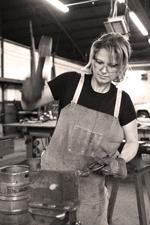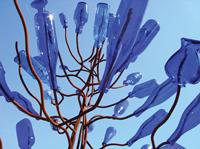- FMA
- The Fabricator
- FABTECH
- Canadian Metalworking
Categories
- Additive Manufacturing
- Aluminum Welding
- Arc Welding
- Assembly and Joining
- Automation and Robotics
- Bending and Forming
- Consumables
- Cutting and Weld Prep
- Electric Vehicles
- En Español
- Finishing
- Hydroforming
- Laser Cutting
- Laser Welding
- Machining
- Manufacturing Software
- Materials Handling
- Metals/Materials
- Oxyfuel Cutting
- Plasma Cutting
- Power Tools
- Punching and Other Holemaking
- Roll Forming
- Safety
- Sawing
- Shearing
- Shop Management
- Testing and Measuring
- Tube and Pipe Fabrication
- Tube and Pipe Production
- Waterjet Cutting
Industry Directory
Webcasts
Podcasts
FAB 40
Advertise
Subscribe
Account Login
Search
Bottle tree boom
Mississippi metal artist finds healing, reveals talent with bottle trees
- By Amanda Carlson
- April 16, 2013
- Article
- Arc Welding

Bottle trees, a staple of the Mississippi landscape, helped Dwyer discover her talent for metal art.
Because of her rough home life growing up, metal artist Stephanie Dwyer of Jackson, Miss., said she used to find refuge among trees. She imagined them as having the ability to come to life, much like the trees in the movie “The Wizard of Oz,” and come to her aid should she need rescuing.
She felt protected in the woods. As an adult, Dwyer still finds refuge among the trees, only these trees are made of metal, bent and welded, and adorned with glass bottles—bottle trees, to be exact. Dwyer has made quite the name for herself with her renditions of the tree, which is popular in the southern U.S. and has a special cultural and historic meaning.
Dwyer always had the desire to build and create. As a child she spent time building forts out of sticks in the woods where she found comfort.
“My brain was always in overdrive. I was always asking myself, ‘What am I going to build now? How am I going to stay busy?’”
That need to build things followed her into adulthood. She often fabricated intricate woven basket frames out of alder saplings for landscape beds. She wove the wood around, forming a basket and filling it with tulip bulbs, river rock, and a willow tree at the center. But after a while the basket would root and grow in certain places or disintegrate altogether. After describing the problem to a friend and local artist, he suggested she switch her focus from wood to metal, which would last a lifetime.
Dwyer took his advice and enrolled in a welding class at Bellingham Technical College, Bellingham, Wash. Welding and metalworking suited her, and she quickly felt at home working with metal. But after a tumultuous and abusive relationship that ended in a broken engagement, Dwyer decided to leave the state of Washington. She packed up her dog, cat, welding power source, and plasma cutter and headed south to Mississippi to be closer to her mother and to begin the emotional healing process.
Bottle Tree Boom
The welding course had given her the skills she needed to take her desire for creating to the next level. She started out making things as gifts for herself, but still did not call herself an artist. It wasn’t until she discovered the bottle trees that she realized she was an artist.
The history of the bottle tree dates back thousands of years and was introduced to the South by African slaves. The trees are a big part of the Mississippi landscape and culture, the belief being that these objects attract the haints—or the evil spirits—that bring bad luck. The haints are drawn into the bottles, become trapped, and are eliminated by the sun’s morning light. Sometimes the bottles themselves—haints and all—are thrown into the river. Once people found out about Dwyer’s talent for making things, they began asking her to make bottle trees.
While most other bottle trees she’s seen are made with rebar, Dwyer uses 3⁄8-in. hot-rolled round stock for trees that are 5 ft. tall or less and ½-in. and 15⁄8-in. solid round stock for larger trees. Each limb on her trees is different, from its length to the way she bends it (see Figure 1).
“I have a left-hand branch and a right-hand branch. I have an assistant who cuts the limbs to a certain length, cleans up the edges, and then bends them a certain way to where I have a left bend and a right bend. Then he stacks them in groups from smallest to largest so I can take what I need. Then I put bottles on the limbs so I can see how they’ll lie on the branches as I’m welding them.”

Figure 1: Each of Dwyer’s bottle tree limbs has a left-hand bend and a right-hand bend. She then places bottles over the limbs while she welds them in place to get an idea of how they’ll lie.
Dwyer’s bottle tree work has shined a spotlight on her artistic talent, and drawn interest from customers from all across the country, at public attractions like the B.B. King Museum, Indianola, Miss., and in select retail outlets in Mississippi, Louisiana, Georgia, and North Carolina . Using a welding power source and plasma cutter, Dwyer can make a standard bottle tree or customize it with leaves and other objects, like a bird perched in its nest (see Figure 2).
The trees even caught the eye of a Savannah, Ga., anthropologist working on a new African-American museum that will be opening at the Smithsonian sometime in 2015.
“She specializes in African-American culture and history and works with museums in the nation by bringing African artifacts for exhibits. She contacted me by Googling ‘bottle trees’ and has since purchased five of them. She flew down here to see the 10-ft. tree, one of the arches I’ve done, and a couple of other pieces that are bottle tree-inspired. If all goes well, I’ll have a 10- or 12-ft. tree at the Smithsonian in the next year.”
“Strange Connection”
The success of her bottle trees has generated a demand for custom work, both bottle tree-inspired and otherwise. Gateways, archways, and home and outdoor décor are just a few of her specialties, but even then Dwyer doesn’t veer too far from what has fueled her passion (see Figure 3).
“The last couple of years people have really sought [bottle trees] out. There seems to be a strange connection with people and these bottle trees. I think part of that is because it’s so unique, but the other part of that is there’s so much history, and once people find out that history, it makes the bottle trees that much more appealing to have.”
Maybe there is a strange connection between people and the bottle trees. After all, Dwyer moved to Mississippi looking for healing and began making the bottle trees. The purpose of the bottle tree, in turn, is to ward off negativity and heal. And Dwyer herself has found healing and has helped other women find it too.
“I’ve done a couple of radio programs here, and they did a video on my work for Mississippi Public Broadcast. I put my situation out there about my ex-fiance because when I went through what I did, I realized that a lot of other women have gone through the same thing; they just don’t talk about it or they blame themselves. Anyway, I think the good thing that has come from this is a lot of women have stepped forward and thanked me for being so open about it and helping them to have the strength to get through it. It’s been a good payoff to use my work to reach people.”
You could say she’s sent her own haint-filled bottles down the river.
About the Author

Amanda Carlson
2135 Point Blvd
Elgin, IL 60123
815-227-8260
Amanda Carlson was named as the editor for The WELDER in January 2017. She is responsible for coordinating and writing or editing all of the magazine’s editorial content. Before joining The WELDER, Amanda was a news editor for two years, coordinating and editing all product and industry news items for several publications and thefabricator.com.
About the Publication
subscribe now

The Welder, formerly known as Practical Welding Today, is a showcase of the real people who make the products we use and work with every day. This magazine has served the welding community in North America well for more than 20 years.
start your free subscription- Stay connected from anywhere

Easily access valuable industry resources now with full access to the digital edition of The Fabricator.

Easily access valuable industry resources now with full access to the digital edition of The Welder.

Easily access valuable industry resources now with full access to the digital edition of The Tube and Pipe Journal.
- Podcasting
- Podcast:
- The Fabricator Podcast
- Published:
- 04/16/2024
- Running Time:
- 63:29
In this episode of The Fabricator Podcast, Caleb Chamberlain, co-founder and CEO of OSH Cut, discusses his company’s...
- Trending Articles
Sheffield Forgemasters makes global leap in welding technology

Welding student from Utah to represent the U.S. at WorldSkills 2024

Lincoln Electric announces executive appointments

Engine-driven welding machines include integrated air compressors

ESAB unveils Texas facility renovation

- Industry Events
16th Annual Safety Conference
- April 30 - May 1, 2024
- Elgin,
Pipe and Tube Conference
- May 21 - 22, 2024
- Omaha, NE
World-Class Roll Forming Workshop
- June 5 - 6, 2024
- Louisville, KY
Advanced Laser Application Workshop
- June 25 - 27, 2024
- Novi, MI



























